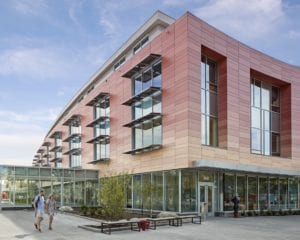Who is a member?
Our members are the local governments of Massachusetts and their elected and appointed leadership.

Cambridge last month opened the new King Open and Cambridge Street Upper School campus, which includes space for both educational and municipal services, and moves the city closer to its goal of becoming carbon emissions neutral. (Photo by Robert Benson)
With a new building complex in Cambridge, the city is providing both educational and community services to residents and working toward its goal of making all buildings carbon emissions-neutral.
At the beginning of this academic year, the city opened the new King Open and Cambridge Street Upper School campus, which includes an elementary school and middle school, school district offices, a public library branch, a community swimming pool, and preschool and after-school programs. The buildings total 273,000 square feet and sit on roughly 4 acres.
The project incorporates several features to improve energy efficiency and to discourage fossil fuel use, including 3,516 photovoltaic panels mounted on the roofs and the buildings’ facades to generate power, 190 geothermal wells that were dug on-site as part of the complex’s heating and cooling system, and a rainwater reclamation system.
In 2015, the City Council adopted the Cambridge Net Zero Action Plan, a 25-year plan to ensure that the city’s carbon-free energy production offsets all greenhouse gas emissions from buildings. To achieve this goal, Cambridge’s plan envisions a combination of energy-efficiency upgrades, renewable energy production and, if needed, the purchase of carbon offsets and credits.
Cambridge’s net zero plan starts with municipal buildings and then moves on to other groups of properties, such as housing, commercial buildings and laboratories, in terms of making existing buildings more energy efficient and in terms of providing incentives and establishing greener requirements for new construction.
Deputy City Manager Lisa Peterson said the city is trying to set an example by starting with its own buildings.
“We’re trying to be leaders in this, and showing [the private sector] that this is possible,” Peterson said.
Because the action plan is still in its early years, the school project is not yet technically net zero emissions, but is “net zero ready.” The property still relies on the electrical grid to a degree, for electricity that doesn’t yet come from 100% renewable sources.
Peterson said the city is working with consultants to figure out the best way to reach the 100% renewable standard and hopes to achieve that goal within the next couple of years.
The new school complex cost the city about $159 million, more than $129 million of which involved construction expenses, according to Michael Black, the city’s construction program manager. Because the project includes a library branch, he said, the city is on the waitlist to receive $3.8 million in funding from the Massachusetts Board of Library Commissioners. It is also expecting to get $460,000 in rebates from Eversource.
Overall, Cambridge used its own money to pay for the bulk of the project and didn’t receive funding from the Massachusetts School Building Authority. Communities that seek to have their projects approved and funded through the SBA, however, can potentially qualify for incentive points for their projects, according to Maria Puopolo, the SBA’s director of external affairs.
“It’s a conversation dictated by the district’s needs,” Puopolo said.
Communities that pursue net zero projects can face significant upfront costs. Cambridge’s photovoltaic panels and labor cost $2.3 million, according to city officials. The city expects to reap significant savings on its energy bills, however. A 2017 consultant’s report projected an annual savings of 42% in energy costs.
Black said features such as an on-demand air ventilation system that activates when people arrive help contribute to the cost savings.
The city also relied on more traditional methods to embrace nature. The project’s design worked around a century-old sycamore tree, Peterson said, and placing parking underground helped create about an extra acre of open space in a dense urban area.